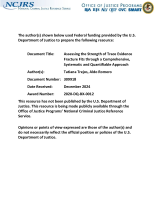Trace evidence
Development of Fast and Comprehensive Approaches for Gunshot Residue Interpretation Using Ambient Ionization, Mass Spectrometry, and Microparticle Sampling Studies
Fit Zeta Distributions to Forensic Data
Development and validation of a systematic approach for the quantitative assessment of the quality of duct tape physical fits
Raman Spectroscopic Examination of Bloodstains for Forensic Purposes : Background and Race Determination
Physical and Chemical Trace Evidence from 3D-Printed Firearms, and Use of a Quadcopter for Targeted Sampling of Gaseous Mercury in the Atmosphere
Effects of Prescreening for Likelihood Ratio Approaches in the Forensic Identification of Source Problems
Characterization and classification of organic gunshot residue from neat smokeless powder, cartridge cases, and the hands of known shooters
The analysis of glass from portable electronic devices and glass accessories using µ-XRF for forensic investigations
Smokeless Powder Residue Analysis by Capillary Electrophoresis
Trace Evidence of Trans-phenyl Propene as a Marker of Smoked Methamphetamine
Assessing the Strength of Trace Evidence Fracture Fits through a Comprehensive, Systematic and Quantifiable Approach
Flashforward: The Current and Future Applications of Vibrational Spectroscopy for Forensic Purposes
Direct Comparison of Body Fluid Identification Technologies
GENETIC MARKERS IN HUMAN SEMEN - 2 - QUANTIFICATION OF POLYMORPHIC PROTEINS
On the reliability of the forensic examination of electrical tapes and the influence of alteration sources encountered in casework
Attribution of tire marks via their elemental profile
Enhancing the evidentiary value of textile fibers with a combination of fluorescence microscopy and micro spectrophotometry
A Universal Method for the Detection of Gunshot Residue using Vibrational Spectroscopy
A Combined Molecular Analysis of Pollen Utilizing Lipid Profiling & DNA Barcoding for Plant Species Identification: A Forensic Application
FITS—Functional Implementation of Thorough and Systematic Approaches for Fracture Examinations
,
Closing Cases Using Gunshot Residue
Closing Cases Using Gunshot Residue
Not every crime scene will have definitive evidence, such as DNA, to link an individual to a crime. In those cases, law enforcement relies on other evidence to build the burden of proof. NIJ graduate research fellow Dr. Shelby Khandasammy developed a tool to analyze organic gunshot residue and distinguish between different firearms calibers and manufacturers. She joins Marie Garcia, office director for the Office of Criminal Justice Systems at NIJ, to talk about her work and experience as a research fellow.




